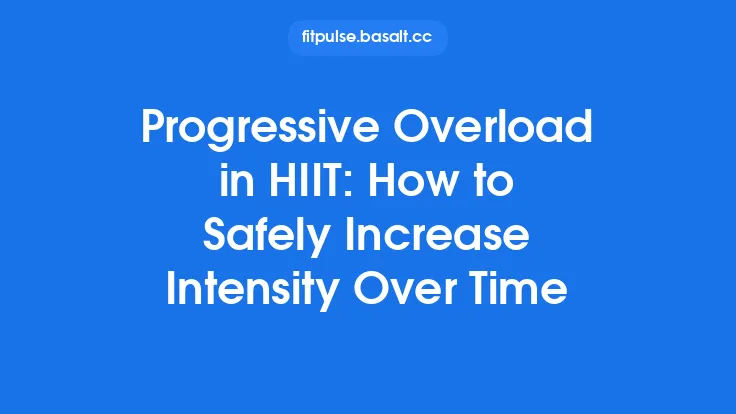Increasing the amount of work you do in a training program—whether by adding more sets, reps, distance, or load—can drive impressive gains in strength, hypertrophy, endurance, and overall fitness. However, doing so without a structured, safety‑first approach raises the risk of overuse injuries, chronic fatigue, and stalled progress. The following guidelines lay out a comprehensive, evergreen framework for safely ramping up volume and intensity over time. They are designed for coaches, athletes, and dedicated lifters who already have a solid grasp of basic training concepts and are looking to refine the way they progress their programs.
Principles of Progressive Overload
- Specificity of Stress
- Overload must target the exact quality you wish to improve (e.g., muscular tension for hypertrophy, metabolic demand for endurance). Adding volume without aligning it to the desired stimulus can dilute the training effect.
- Gradualism
- The body adapts best to small, consistent increments. Large jumps in load or volume overwhelm recovery systems and increase injury risk. A rule of thumb is the “2‑10‑20” principle: ≤2 % increase in load, ≤10 % increase in volume (sets × reps), or ≤20 % increase in session duration per micro‑cycle.
- Progressive Tension Over Time (PTOT)
- Track the cumulative tension placed on a muscle or system across weeks. This metric (load × reps × sets) provides a single number that can be incrementally increased, ensuring both volume and intensity rise in a balanced manner.
- Reversibility
- Gains are lost when stimulus is removed. Periodic “maintenance weeks” with slightly reduced volume/intensity help preserve adaptations while allowing tissues to recover.
Establishing a Baseline and Baseline Testing
Before any progression, you need a reliable starting point:
- Performance Baseline: Conduct a repeatable test that reflects the primary goal (e.g., 5‑RM squat for strength, 5‑km time trial for endurance). Record the load, time, or repetitions achieved with proper technique.
- Technical Baseline: Video or coach‑review key lifts/movements to ensure form is solid at the current load. Poor technique at baseline will be magnified as load increases.
- Physiological Baseline: Note resting heart rate, sleep quality, and subjective wellness scores. These metrics become reference points for detecting excessive fatigue later.
A baseline should be re‑tested every 4–6 weeks to confirm that the progression plan is delivering the intended adaptations.
Incremental Load Increases: How Much Is Too Much?
| Variable | Typical Safe Increment | When to Use Larger Increments |
|---|---|---|
| External Load (kg/lb) | +2.5 kg (5 lb) for lower‑body compound lifts; +1.25 kg (2.5 lb) for upper‑body | When the athlete consistently exceeds 10 % RPE on the final rep of a set for three consecutive sessions |
| Repetitions per Set | +1 rep per set (e.g., 8 → 9) | If the set is well below the target rep range and technique remains flawless |
| Sets per Exercise | +1 set per week (max 2 extra sets) | Only after a minimum of two weeks of stable performance at the current set count |
| Training Duration (cardio) | +5 % session time (e.g., 30 → 31.5 min) | When heart‑rate recovery remains within target zones and perceived exertion is ≤6/10 |
Key tip: Apply only one variable change per micro‑cycle. Simultaneous increases in load, reps, and sets compound stress and obscure the source of any emerging issues.
Periodization Frameworks for Safe Progression
- Linear Periodization (Classic Model)
- Structure: Gradual increase in intensity (load) while volume (sets × reps) decreases across mesocycles.
- Safety Edge: Predictable progression makes it easy to schedule deloads and monitor fatigue trends.
- Undulating (Non‑Linear) Periodization
- Structure: Daily or weekly fluctuations in intensity and volume (e.g., heavy‑light‑moderate days).
- Safety Edge: Provides built‑in variation, reducing monotony and allowing higher overall weekly volume without chronic overload.
- Block Periodization
- Structure: Focused “blocks” of high volume (accumulation), moderate intensity (transmutation), and high intensity/low volume (realization).
- Safety Edge: Concentrates stress in defined windows, followed by clear recovery phases, making it easier to track cumulative fatigue.
Implementation Note: Choose a model that aligns with the athlete’s competition schedule, training experience, and personal preference. Regardless of the model, embed a planned deload every 4–6 weeks.
Auto‑Regulatory Tools and Real‑Time Feedback
While percentage‑based loading is common, auto‑regulation tailors progression to day‑to‑day readiness:
- Velocity‑Based Training (VBT): Use a linear position transducer to measure bar speed. If velocity drops >5 % from baseline, reduce load or volume for that session.
- Heart‑Rate Variability (HRV): A morning HRV dip >10 % from a 7‑day rolling average may signal insufficient recovery; consider a lighter day.
- Subjective Wellness Questionnaires: Simple 1‑10 scales for sleep, stress, and muscle soreness can guide micro‑adjustments without sophisticated equipment.
These tools help avoid “one‑size‑fits‑all” jumps and keep progression aligned with the athlete’s current physiological state.
Deloads, Micro‑Cycles, and Planned Recovery
- Deload Types:
- Volume Deload: Reduce sets/reps by 30‑50 % while keeping load constant.
- Intensity Deload: Reduce load by 10‑20 % but maintain volume.
- Hybrid Deload: Combine modest reductions in both load and volume.
- Micro‑Cycle Design:
- A typical 7‑day micro‑cycle may consist of 3 heavy days, 2 moderate days, and 2 active‑recovery days. The exact distribution should reflect the chosen periodization model.
- Recovery Modalities:
- Prioritize sleep hygiene, nutrition (especially protein and omega‑3s), and mobility work. Incorporating low‑intensity aerobic sessions (e.g., 20‑30 min at <60 % HRmax) on recovery days can enhance circulation without adding significant stress.
Monitoring Fatigue and Early Warning Signs
| Indicator | What It Suggests | Action |
|---|---|---|
| Persistent joint pain >48 h | Overuse or technique breakdown | Reduce load, assess biomechanics |
| RPE consistently >8 on “easy” sets | Accumulated systemic fatigue | Insert a deload or extra recovery day |
| Decreased bar velocity >5 % across multiple sets | Neuromuscular fatigue | Lower load or volume for the session |
| Elevated resting HRV (lower values) | Autonomic stress | Prioritize sleep, nutrition, and consider a lighter day |
| Mood disturbances or lack of motivation | Psychological stress | Reduce training load, incorporate enjoyable activities |
Regularly logging these metrics creates a data set that can predict plateaus or injury risk before they manifest.
Individual Factors That Influence Progression Pace
- Genetic Fiber-Type Distribution – Fast‑twitch dominant athletes may tolerate larger load jumps, whereas endurance‑oriented individuals respond better to volume increments.
- Training Age – Novices often see rapid gains with modest increases; seasoned lifters require finer, more frequent adjustments.
- Hormonal Status – Periods of high cortisol (e.g., during high life stress) may necessitate slower progression.
- Lifestyle Variables – Shift work, travel, and nutrition quality directly affect recovery capacity and thus the safe magnitude of progression.
- Injury History – Prior joint or tendon issues demand a more conservative approach, emphasizing technique reinforcement before load escalation.
Tailor the “2‑10‑20” increments to these personal variables rather than applying them universally.
Documentation and Data‑Driven Adjustments
- Training Log Structure:
- Date, Exercise, Load, Sets, Reps, RPE, Velocity (if available), HRV, Sleep Hours, Mood.
- Weekly Review:
- Calculate PTOT for each movement, compare to the previous week, and note any deviations in performance or wellness.
- Trend Analysis:
- Use simple spreadsheets or apps to plot PTOT, RPE, and HRV over 4‑week blocks. Look for upward trends in PTOT accompanied by stable or improving HRV—this indicates a healthy progression.
- Decision Matrix:
- If PTOT ↑ + HRV ↓ → consider deload.
- If PTOT ↔ + RPE ↑ → adjust technique or reduce volume.
- If PTOT ↑ + RPE ↔ + HRV ↔ → continue progression as planned.
A systematic documentation habit transforms anecdotal “feeling” into actionable intelligence.
Practical Checklist for Implementing Safe Increases
- [ ] Baseline Established: Performance, technique, and physiological metrics recorded.
- [ ] Progression Model Chosen: Linear, undulating, or block periodization selected.
- [ ] Increment Limits Set: Load ≤2 %, volume ≤10 %, duration ≤20 % per micro‑cycle.
- [ ] Auto‑Regulation Tools Ready: VBT device, HRV app, or wellness questionnaire in place.
- [ ] Deload Schedule Planned: Every 4–6 weeks, with clear type (volume, intensity, hybrid).
- [ ] Monitoring System Active: Daily logs of RPE, sleep, mood, and any pain.
- [ ] Review Cycle: Weekly data review and monthly PTOT trend analysis.
- [ ] Adjustment Protocol: Pre‑defined actions for each warning sign (e.g., “if RPE >8 on two consecutive sessions, reduce load by 5 %”).
- [ ] Recovery Strategies Integrated: Sleep, nutrition, mobility, and low‑intensity cardio incorporated into the weekly plan.
By ticking off each item, coaches and athletes can confidently increase training volume and intensity while minimizing the risk of overtraining and injury. The key is consistency—both in applying the guidelines and in tracking the data that informs them. When done correctly, progressive overload becomes a reliable engine for long‑term performance gains.





